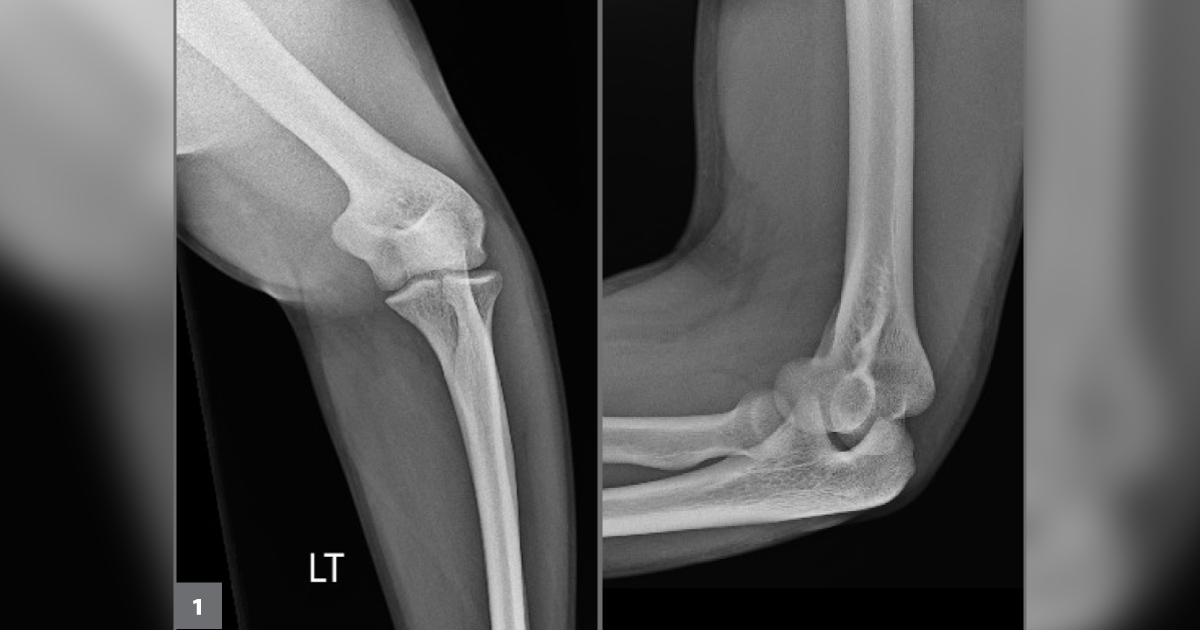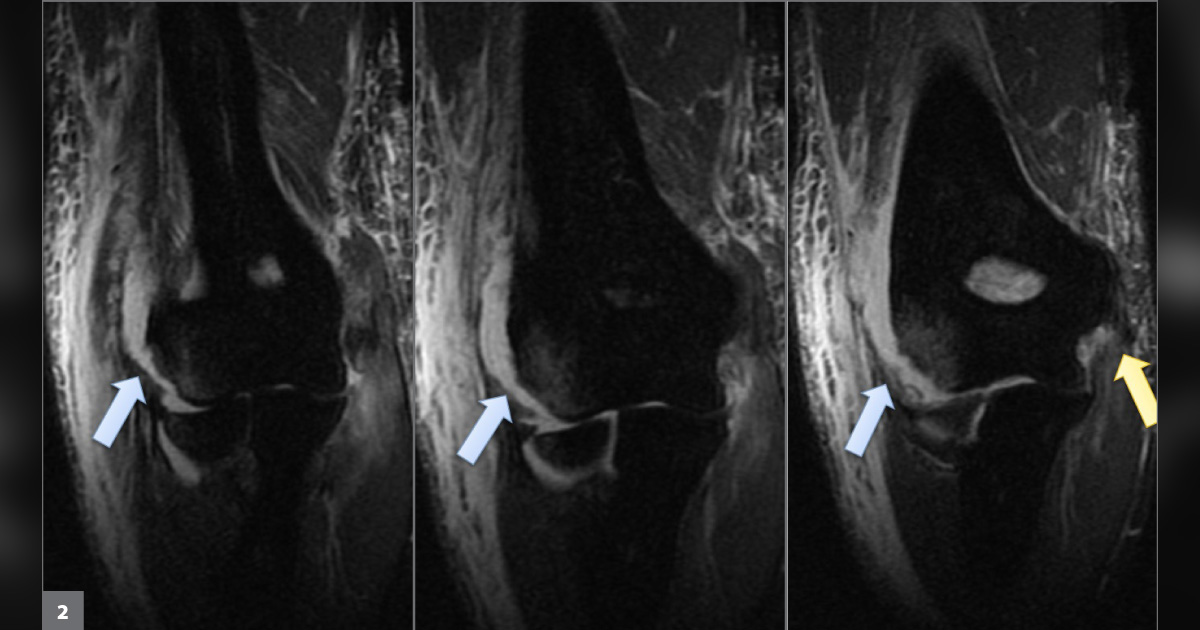College football player with persistent instability after an elbow dislocation
A 19-year-old, otherwise healthy, right-handed male college football player sustained a left posterior elbow dislocation after a fall on an outstretched hand during practice.
The patient was reduced acutely by an athletic trainer; while the patient was laying prone with his elbow in slight flexion, the trainer pulled inline traction and placed direct pressure on the olecranon.


The patient was brought into clinic after the reduction with significant pain. Examination was notable for swelling and tenderness to palpation about the entire left elbow. He was hesitant to move his elbow and his range of motion was limited to an arc of 60° to 100° secondary to pain. His elbow was unstable to varus and valgus stress, as well as posterolateral rotatory instability testing. Plain films showed a concentrically reduced left elbow with no fracture, but with widening of the radiocapitellar joint space (Figure 1). He was splinted with the elbow at 90° acutely and transitioned to a hinged elbow brace the next day.

Source: Felix H. Savoie III, MD, FAAOS, FAOA
As described by Michael P. McCabe, MD, and colleagues in 2012, the standard treatment for first-time elbow dislocations is conservative management. Patients often have significant improvement in pain after reduction and can return to unrestricted activities quickly. However, at this patient’s follow-up appointment 2 days later, he continued to complain of significant pain and apprehension. His elbow still had ligamentous instability and began to subluxate as it was brought into extension at about 30° to 45°.

Due to this persistent instability, additional work-up, including MRI of the elbow, was done. This demonstrated significant intramuscular edema, a proximal ulnar collateral ligament (UCL) tear from the medial epicondyle and complete avulsion of the lateral ligament structures off the lateral epicondyle (Figure 2).
What are the treatment options?
See answer below.
Surgical treatment is indicated for gross elbow instability, to keep athlete in play
The management of simple elbow dislocations primarily involves nonoperative treatment. Limited immobilization with early range of motion is used to help patients return to pre-injury activities sooner and minimize the risk of joint contracture, the most common adverse event associated with conservative treatment.
Surgical treatment is indicated for elbows that remain unstable after reduction. Operative management involves exploration of the joint, repair or reconstruction of the lateral ligament complex and an assessment of the need for repair or reconstruction of the medial ligament. Open and arthroscopic techniques have been described for surgical treatment and both are associated with excellent patient outcomes. In a retrospective review of 54 patients with posterolateral rotatory instability, Felix H. Savoie III, MD, FAAOS, FAOA, and colleagues, demonstrated no statistically significant difference between the results of open repair in 30 patients vs. arthroscopic repair in 24 patients. Andrews-Carson scores for the arthroscopic repairs improved from 146 to 176 (P = .0001) and scores for the open repairs improved from 144 to 182 (P < .001).
Several factors were taken into account when discussing treatment options with this athlete. He is an in-season elite-level athlete and the trial of conservative treatment had not yielded any benefit early in his care. Continuing nonoperative management with further immobilization would put him at risk for elbow stiffness, as well as keep him out of play. Early repair has been shown to decrease the risk of residual stiffness by stabilizing the elbow to allow for earlier range of motion. Taking all of this into consideration, the patient elected to proceed with operative intervention.
Operative technique
The patient was placed in the prone position with appropriate padding under his body. A bump was positioned under the elbow to allow the surgeon to flex the elbow over the bump. An exam under anesthesia was performed, which demonstrated gross elbow instability with the elbow dislocating on minimal posterolateral stressing. The elbow was insufflated with 10 mL normal saline via an 18-gauge needle through a direct posterior approach and a proximal anterior medial portal was established. A large hematoma was able to be evacuated from the joint at this time. Diagnostic arthroscopy was undertaken, which revealed that medially the brachialis was torn from its insertion on the coronoid process, the anterior capsule was disrupted and there was a small tear in the UCL proximally. Examination of the lateral side of the joint revealed a small defect of cartilage of the radial head where it had dislocated. The extensor carpi radialis brevis (ECRB) tendon was intact, but the lateral collateral ligament (LCL) was loose and there was laxity of the annular ligament.

A posterior central portal was established, leaving the inflow anteriorly. Continuing the diagnostic scope, damage and stretching of the posterior band of the medial UCL was found. Examination of the lateral gutter revealed the entire lateral capsule folded into the ulnohumeral articulation. (Figure 3, page 22).
Repair lateral ligamentous structures
We proceeded with repair of the lateral ligamentous structures using the preferred method of co-author Savoie. A straight lateral portal was established to retrieve the lateral capsule from the ulnohumeral articulation. A loaded suture anchor was then placed at the isometric point of the radial collateral ligament, determined by the footprint. One limb of the suture anchor was placed through the ECRB and three limbs were placed through the LCL and lateral capsule. A second anchor was then placed more proximally; two of its limbs were passed through the lateral capsule and one through the radial ulnar humeral ligament. One more limb was passed proximally where the periosteum had been stripped adjacent to the tip of the olecranon and this was tied down and used to repair the anconeus, as well. The sutures were tied from distal to proximal with the elbow slightly extended to complete the repair.
The elbow was ranged and found to have excellent stability. The scope was then placed back into the front where we were able to visualize the restored anterior capsule. The patient had no further valgus instability after the lateral repair and, thus, medial repair was not indicated. He was placed in a hinged elbow brace in 60° flexion. Postoperative radiographs showed maintained reduction of the elbow (Figure 4).

The postoperative course included painless range of motion exercises and the patient was ready to begin physical therapy at 1 week postoperatively. His range of motion at 10 weeks after surgery indicated normal elbow function with 125° passive flexion, 120° active flexion, 0° both passive and active extension, normal supination and pronation and general strength measuring 4+/5. He has worked with athletic trainers daily and has resumed play as a collegiate football player.
Discussion
The elbow is the second most commonly dislocated joint in the upper extremity after the shoulder, and 10% to 30% of injuries to the elbow are dislocations. Elbow dislocations are commonly an athletic injury that occurs during a fall on an outstretched hand, causing a combination of axial-compressive and rotational-shear forces. Simple elbow dislocations are defined as those with only ligamentous injury, while complex dislocations additionally involve periarticular fractures.
Conservative treatment in a brace is the gold standard for simple elbow dislocations, but recovery of functional motion may take 6 weeks or more and return to full activities may take longer. Extended periods of immobilization (> 3 weeks) have been associated with poor outcomes including recurrent instability and more commonly contracture of the elbow joint. Range of motion should be initiated as early as possible to decrease the risk of these sequelae.
In 1991, Shawn W. O’Driscoll, MD, and colleagues, described posterolateral rotatory instability (PLRI). This results from the incompetence of the radial ulnohumeral ligament (RUHL), which typically avulses off the humerus during dislocation and allows the proximal radioulnar joint to rotate and the radial head to subluxate posteriorly when stressed. One such exam is the lateral pivot-shift test where the examiner supinates the forearm and then applies a valgus stress while axially loading and bringing the elbow from full extension to 40° flexion.
Intraoperatively, PLRI is confirmed by noting posterior subluxation of the radial head during forearm supination. Additionally, we were able to demonstrate the “drive through sign” during the initial arthroscopic examination. This sign, originally described by Savoie and colleagues, refers to driving the arthroscope across the ulnohumeral joint space from the lateral gutter into the medial gutter, consistent with an unstable elbow. During the repair, tying the sutures and retensioning the lateral ligament complex has the effect of pushing the arthroscope out of the posterolateral gutter, effectively eliminating the “drive through sign” and confirming that stability has been restored to the elbow.
Michael J. O’Brien, MD, and colleagues, demonstrated that high-demand patients, like the one in this case, may be candidates for acute arthroscopic ligamentous repair to restore stability and allow them a quicker return to full activities at their pre-injury level. The retrospective review of 14 patients with simple elbow dislocation who underwent arthroscopic repair of the RUHL showed the mean time to return to full activities in and out of a brace was 2.7 weeks and 6.6 weeks, respectively, in the acutely repaired group (< 3 weeks) and 4.6 weeks and 8.9 weeks, respectively, in patients repaired in the subacute period (5 to 12 weeks).
The patient described in this case belongs to this category of high-demand individuals who may have earlier return-to-sport outcomes with surgical intervention. Additionally, his intraoperative findings further suggest that he benefitted from operative intervention with his entire lateral capsule folded into his ulnohumeral articulation, which added to the difficulty of maintaining a concentric reduction. Operative management of elbow dislocation should be considered in the appropriately selected patient to allow for a quicker return to full preinjury activity level.
- References:
- Holt MS, et al. Hand Clin. 2004;doi:10.1016/j.hcl.2004.07.003.
- McCabe MP, et al. Phys Sportsmed. 2012;doi:10.3810/psm.2012.02.1952 .
- Mehlhoff TL, et al. J Bone Joint Surg Am. 1988;70:244-249.
- O’Brien MJ, et al. Arthroscopy. 2014;doi:10.1016/j.arthro.2014.02.037.
- O’Brien MJ, et al. Sports Med Arthrosc Rev. 2014;doi:10.1097/JSA.0000000000000029.
- O’Driscoll SW, et al. J Bone Joint Surg Am. 1991;73:440-446.
- Rettig AC. Orthop Clin North Am. 2002;doi:10.1016/s0030-5898(01)00017-7.
- Savoie FH, et al. Clin Sports Med. 2010;doi:10.1016/j.csm.2010.06.008.
- Savoie FH, et al. Hand Clin. 2009;doi:10.1016/j.hcl.2009.05.010.
- Smith JP, et al. Clin Sports Med. 2001;doi:10.1016/s0278-5919(05)70246-5.
- Yadao MA, et al. Instr Course Lect. 2004;53:607-614.
- For more information:
- Caroline B. Granruth, BA, is a fourth-year medical student. Kelly L. Hill, MD, is a resident physician. Ian Savage-Elliott, MD, is a chief resident. Felix H. Savoie III, MD, FAAOS, FAOA, is Ray Haddad Professor and chair of the department of orthopaedic surgery at Tulane University. They can be reached at 1415 Tulane Ave., New Orleans, LA 70112. Granruth’s email: cgranruth@tulane.edu. Hill’s email: khill8@tulane.edu. Savage-Elliott’s email: iansavageelliott@gmail.com. Savoie’s email: fsavoie@tulane.edu.
- Edited by Travis Frantz, MD, and Ian Savage-Elliott, MD. Frantz is a sports medicine and shoulder fellow at TRIA Orthopaedic Center in Minneapolis. He completed his orthopedic surgery residency at The Ohio State University Wexner Medical Center in Columbus, Ohio. Savage-Elliott is a chief resident in the department of orthopedic surgery at Tulane University Medical Center in New Orleans. He will pursue fellowship training in foot and ankle and sports medicine following residency completion. For information on submitting Orthopedics Today Grand Rounds cases, please email: orthopedics@healio.com.
